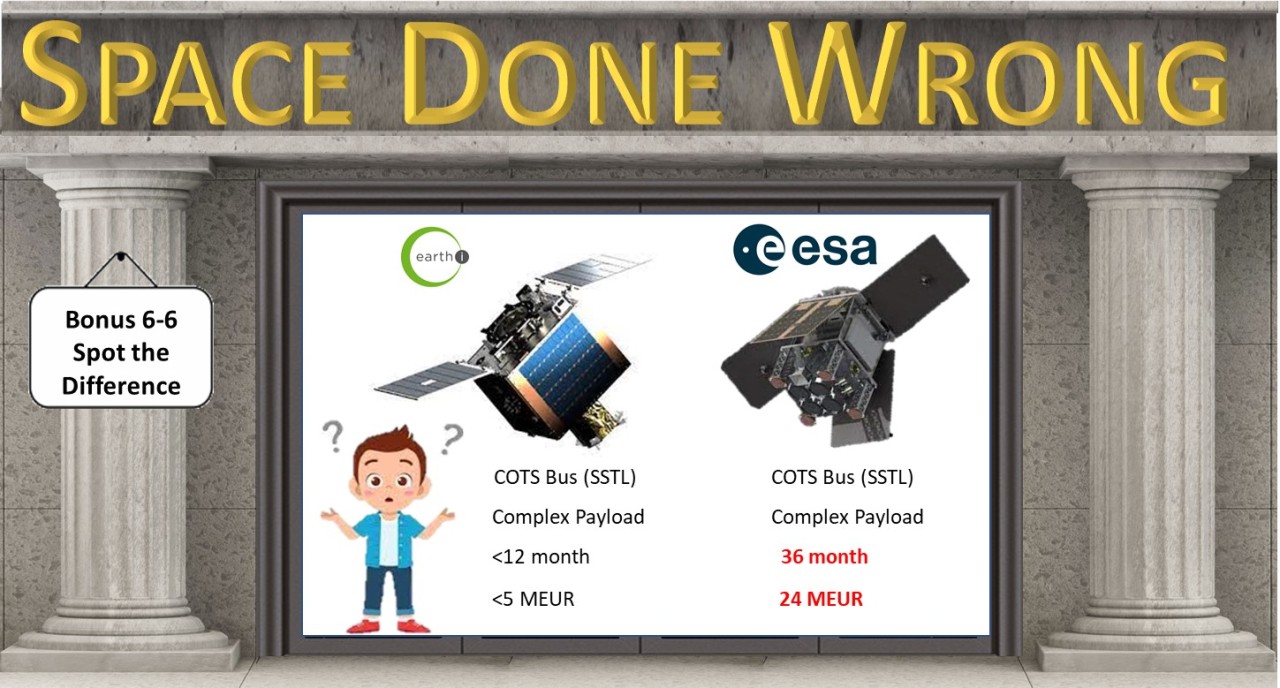The topic of this main episode is “how to waste money and human ingenuity” in this bonus feature we will find evidence that the environment in which a mission is designs matters as much as the mission when it comes to cost and speed of implementation. Or how else it s possible that small satellite missions of the European Space Agency (ESA) seem to always cost 20+MEUR even from a manufacturer and using a flight proven platform that otherwise never would? Let’s have a look!
Meet SSTL X50
When SSTL X50 was introduced publicly in 2014 it was a real looker! Started in 2011 as an internal project with the code name “fireworks” it aimed to be scalable, fast to manufacture with a small team and low cost. So much so, that SSTL showed it was able to build the Carbonite satellite with a team of 6 persons in 6 month. Since labour cost dominates the cost in satellites they were able to show not only the aim but also the ability to manufacture it for GBP 1.5M. [1] Needless to say that SSTL X50 had a profound effect on the business at Berlin Space Technologies [2], but this will be the topic of a different article.

The X50 is SSTL micro satellite platform designed to carry a wide range of payloads. And while it is not simple to find an actual price figure there are several sources available which indicate a sticker price of around 5MEUR today. [3]
The X-50 of SSTL a bus designed for scalability (50-200kg) mass manufacturing ready with low NRE.
In a recent article I came forward and said that the IOD mission of EC/ESA would have benefited from using an SSTL X50 bus and that it would be the obvious choice if not for the fact that the UK left the EU and that EC funding demanded a European Solution. [4]
X-50 has proved to be useful for missions that demand performance at low cost & fast
It should be noted that while the platform stayed the same it has already seen three different names. Originally X50, then X42 (nod to Hitchhikers Guide to the Galaxy) and now X21 (as part of the SSTL Micro class). This is however all the same spacecraft. [11]
Meet ESA Scout Program
The ESA Scout program is an approach of ESA to get small COTS based platforms to be used in scientific earth observation.
“The Scout Missions are the first ESA-EOP Research missions, thus driven by scientific objectives, based on reduced budgets (30Meuro) […]. The Scout mission(s) consist of one or several small satellites for rapid prototyping and demonstration purposes of novel Earth observation techniques in Earth science and related non-commercial applications.” [7]
Scout missions are done in a two step process, mission concept and implementation.
- Step 1 – “Scout Mission Concept and System Consolidation Studies”.
- Step 2 – upon completion of the consolidation study one or maximum two mission concept(s) will be financed for implementation.
The implementation of this second step is on merit alone: according to ESA on “technical and scientific merit” or “mission concept(s) at programmatic level” as identified in step 1.
According to ESA [7] four mission concepts have been identified for further study:
- HydroGNSS: GNSS reflectometry
- Tango: Methan monitoring at high resolution to identify individual sources
- NanoMagSAT: magnetosphere monitoring
- ESP-MACCS: limb sounding for H2O, CO2, CH4, O3, N2O
Meet the HydroGNSS Mission
According to SSTL and ESA the HydroGNSS mission has been selected as a scout mission for implementation. [8],[9]

“Surrey Satellite Technology Ltd (SSTL) and the European Space Agency (ESA) have signed a contract today for HydroGNSS, a 55kg small satellite to measure climate change variables. The contract, with an initial value of €24 million […] was awarded under ESA’s new Scout programme, set up to prove new concepts for Earth Observation using small satellites by exploiting a rapid build programme targeting 3 years from kick-off to launch and a maximum cost of €30m.” [8]
I find it strange that ESA manages to take a platform that is known to be affordable and fast and make it expensive and slow.
Considering that even SSTL now states 24MEUR and 3 years for this mission (and considering that ESA rules forbid any noteworthy profit – see innovation does not pay) it really makes me wonder whether there is a secret ingredient to ESA missions that makes them both slow and excessively expensive?
I might have a few questions…
There are a couple of things that I find strange in this announcement:
- GNSS reflectometry is hardly a new concept. SSTL itself has done research on it using small satellites [9] and various other players [12][13], too. How I understand its more an evolution than a revolution. Should ESA not have aimed higher considering the profile that Scout is supposedly for?

- 24MEUR for a 55kg satellite seems a bit excessive considering that this satellite uses a flight proven SSTL-X50 platform that is being sold for 5MEUR including payload to other customers. How at 24MEUR is this an example for cost effective implementation?
Two mission, same platform one costs 5MEUR the other 24MEUR. Is it safe to assume the price difference has something to do with the customer?
- The SSTL-X50 platform is known for rapid design and assembly with less than 12 month from kick-off to launch. How is it a success that this ESA mission takes 3 years?
SSTL X-50 is a platform that has shown mission implementation in 6 month. Normally <12 are a given. Why is this mission so slow?
- Is the “initial value” statement a slip of the tongue or an admission that ESA missions anyway get more expensive anyway because people play the game of CCN’s?
Dear ESA are you not worried if your supplier announces a “initial value” of 24MEUR right after signing the contract?
What would I have made different?
First of all I might not have all the facts, yet. I have reached out to ESA scout office but not heard back yet. In addition, there is this deviation between technical papers and mission announcement that one shows two satellites and the other only one.
Why is it that ESA micro satellite missions always cost 20+MEUR?
That said a 24MEUR mission price is still bloated even if you consider two satellites. This is is particularly obvious this time round since SSTL X-50 a bus ready for mass manufacturing (with very low recurrent) and the the payload itself is probably also dominated by NRE.
Even if you start out with a platform that never does?
In general we need to talk about the fact that all ESA small satellite missions cost in the range of 20-30MEUR and take 3-4 years to do whereas the same suppliers outside the ESA environment are able to do things for drastically less and much faster.
How can you help:
This text is part of a series of articles in which the author sets the framework to start a discussion about the wrongs of the space industry. If you have experienced similar things, leave a comment. Other views and opinions are very welcome, too, as they may present a way forward. Please be kind to each other.
Disclaimer
The author’s views are his own do not represent the views of Berlin Space Technologies.
Sources:
[1] X50 Production Engineering
[2] IAC-18,B4,7,12,x47966 How to build a satellite in a week – The road towards satellite mass manufacturing, Segert et al.
[3] EC IOD study or if link is no longer active: Space Done Wrong Bonus 7-3
[4] Space Done Wrong Bonus 7-1
[5] ESA Scout in ESA Earth Observation (EO) Missions and Technology (Spacetech 2019), Josep Rosello from ESA
[6] ITT for Scout Mission Studies found at ROSA
[7] SSC20-V-04, Overview of ESA’s Earth Observation upcoming small satellites missions, Pastena et al.
[8] SSTL press release HydroGNSS
[9] SSTL press release on GNSS reflectometry on UK Techdemosat, Cygness
[10] An Introduction to the HydroGNSS GNSS Reflectometry Remote Sensing Mission, Unwin et al.
[11] SSTL Micro Class
[12] Earth Remote Sensing using Surface-Reflected GNSS Signals (GNSS-Reflectometry), Lowe et al. (slide 10)
[13] GFZ Helmholtz Centre Potsdam, GNSS-R ressearch


Leave a Reply